Martin P.M. Handbook of Deposition Technologies for Films and Coatings, Third Edition: Science, Applications and Technology
Подождите немного. Документ загружается.


Glancing Angle Deposition 651
Interestingly, some of the values are beyond the minimum and maximum values for the
stationary interface models, though this is less conclusive for the KPZ
max
limit. Further
experimental and theoretical work will be required to quantify this property of GLAD films.
Given the incomplete understanding of the issues controlling the scaling of column
width in GLAD films, an empirical approach for each deposited material will be
necessary.
13.4.1.3 Magnetic Anisotropy
On a sufficiently small scale, surface effects and boundary conditions strongly influence the
magnetic properties of structured material. Much research has examined magnetic properties
of such materials and how they can be controlled by GLAD. Early studies in oblique
deposition of magnetic materials observed pronounced anisotropy, where the material
possesses a hard and an easy magnetization axis [28, 59, 204–209]. This anisotropy is created
by the columnar structure of the deposited film and is not a product of crystallinity or strain.
Magnetic properties of slanted post films can be explained using two anisotropy fields, H
1
and
H
2
[59]. Field orientation is determined by the columnar structure: H
1
is parallel to the column
axis and H
2
lies in the substrate plane, orthogonal to H
1
. The film planar anisotropy is the
difference between H
2
and the planar projection of H
1
. By varying film structure, it is possible
to control the magnetic anisotropy magnitude. The magnetic anisotropy can further be tailored
by simultaneously depositing two different materials from opposite directions [147, 210–213].
This produces compositionally graded columns with complicated ferromagnetic and
non-ferromagnetic domain structures.
Recent research continues to examine the magnetic properties of GLAD films, with new
approaches including magnetic force microscopy [46, 214], optical techniques [46, 215], and
scanning tunneling microscopy [216]. These studies provide more information about
anisotropy, coercivity, and domain formation in these structures.
13.4.1.4 Organic Materials
Direct organic material deposition with GLAD has been studied by several groups [78, 79, 83,
87, 91, 92]. Pursel et al. used a nozzle to direct vaporized parylene C onto a substrate at an
oblique angle [87]. The parylene C subsequently polymerizes, but retains GLAD film
structures. One of the more remarkable results in this area has been the Alq
3
structures
produced by Hrudey et al. [78]. Scanning electron microscope (SEM) images of characteristic
Alq
3
helical GLAD thin films are shown in Figure 13.19. These films are extremely smooth,
exhibit excellent uniformity, and self-organize over short distances into hexagonal-close
packed ordering. The deposition of organic materials with GLAD is a rapidly developing field,
and interesting results are expected as these new materials are investigated.
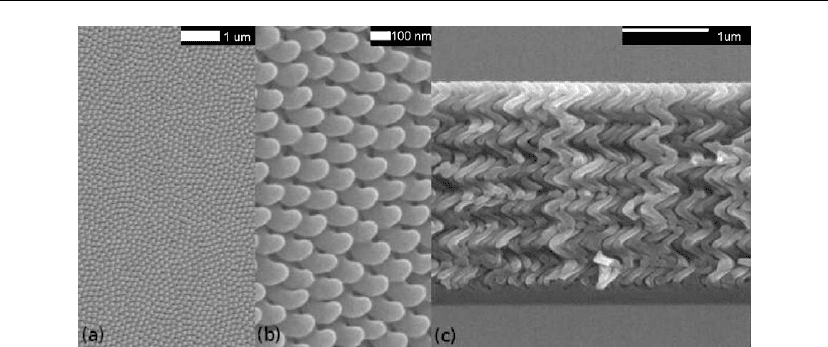
652 Chapter 13
Figure 13.19: Alq
3
columns fabricated using the GLAD technique self-assemble in an ordered
manner. The columns themselves maintain their shape, the number of columns and an increase in
their spacing throughout the thickness of the film and exhibit a much greater uniformity from
column to column. (Reproduced with permission from [169], © Wiley-VCH.)
13.4.2 Column Ensemble Properties
13.4.2.1 Interface Width
Interface width is defined by the statistical distribution of column heights. Similar to column
width, it has been found to follow a power law with film thickness:
T
interface
(
t, α
)
∝ t
β
(
α
)
(13.11)
where T
interface
is the interface thickness, t is film thickness, α is deposition angle, and β is a
characteristic growth coefficient which depends on deposition angle α. Note that the use of β
here does not represent column tilt angle. Surface roughness of GLAD films has been studied
by several groups [68, 71, 73, 84, 102, 217, 218]. A summary of results for β from the
literature is given in Figure 13.20. A strong dependence on deposition angle is observed, rising
to a nearly linear scaling of surface roughness with film thickness for highly oblique
depositions. Although only a limited data set is available from the literature, the report of Vick
et al. [218] and the strong trend observed here suggests that this parameter depends less on
material than the column width parameter discussed in Section 13.4.1.2.
Another measure of GLAD surface roughness can be made by treating it as a self-affine
surface; this measure depends only weakly on deposition angle [73, 84]. A final point is that
surface roughness depends on rotation rate [70], which may offer an additional degree of
control over this property.
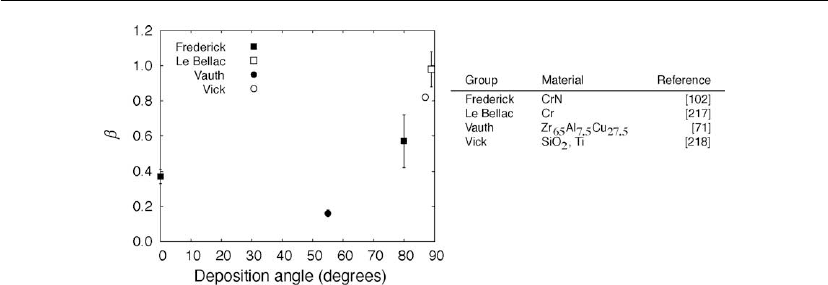
Glancing Angle Deposition 653
Figure 13.20: Literature values for the interface growth coefficient β. A value of β=1 indicates that
surface roughness scales linearly with film thickness. Experimental data are described in the table.
13.4.2.2 Areal Column Density
Areal column density has not been studied as much as other properties, although a few reports
of specific materials have been made [38, 91, 130, 158, 219, 220]. Typical values in the range
of ≈ 20 columns per square micrometer are observed for films at least a few hundred
nanometers thick. For specific materials, a few general trends do exist. As a result of column
competition, areal column density decreases with film thickness [91, 219, 220]. Similarly,
increasing substrate temperature has been shown to decrease column number density
[130, 158].
Column number density is closely related to column width, which is not yet well understood
(see Section 13.4.1.2). In general, understanding GLAD column areal density scaling will
require an improved understanding of column width scaling, which remains an open research
question. Column density varies with film thickness, deposition angle, and material, and must
be evaluated for any given application. In some cases, it should be possible to exert some
influence over column density through the advanced substrate motion control techniques
discussed in Section 13.3.2.1.
13.4.2.3 Surface Area
The columnar microstructure of GLAD films can result in large surface areas. The surface area
of GLAD films has been studied in several reports, including experimental measurements
[53, 69, 157, 221–226], simulations [227], and geometric estimates [142]. Figure 13.21
summarizes the experimental literature values as a function of α and material.
Surface area increases with deposition angle up to ≈ 70
◦
, and then decreases slightly; peak
location varies with material. The surface area magnitude also depends on material, with
oxides tending to exhibit higher surface areas than pure elements. The data reported by Kim
et al. for Pd are an exception to this general trend, deposited at an extremely low temperature
of 22 K [69]. It is clear that deposition temperature does play a significant role from the TiO
2
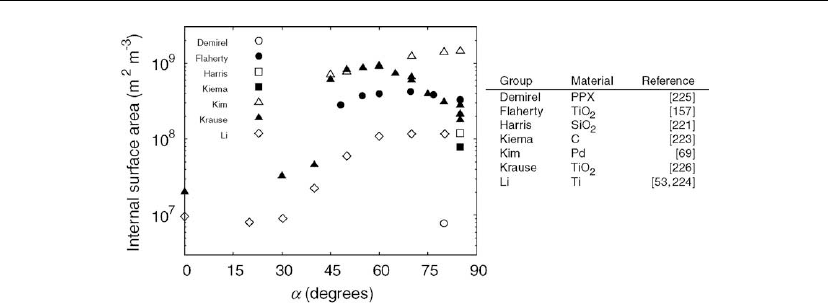
654 Chapter 13
Figure 13.21: Literature values for surface area of GLAD thin films as a function of deposition
angle and material. A strong dependence on material is observed. The Flaherty data and Krause
data are for TiO
2
. The discrepancy is attributed to different substrate temperatures during
deposition: Flaherty deposited at 100 K, while Krause left substrate temperature uncontrolled.
Experimental data are described in the table. Several data points are not visible due to overlap
with other results.
data from Flaherty et al. and Krause et al., who deposited at 100 K and above room
temperature, respectively [157, 226]. However, further work will be required to evaluate the
impact of deposition temperature on GLAD surface area.
13.4.2.4 Mechanical Properties
Because GLAD films are composed of separated columns rather than a continuous solid film,
interesting mechanical properties are observed. GLAD films can act as stress relief layers, and
stiffness can be adjusted through film microstructure. In general, these properties are the
product of an ensemble of columns, but some work has successfully isolated the mechanical
properties of single GLAD columns. Some studies have also been made of the mechanical
response of GLAD films to droplets encompassing an ensemble of columns.
Hardness
Hardness of GLAD films has been studied by several groups [27, 43, 95, 160, 228].
Researchers have found that hardness decreases with α, and a summary of literature results is
found in Figure 13.22. Lintymer et al. have studied hardness for Cr films composed of slanted
posts [27] and chevrons [43]. The data suggest that structure type and period number of a
GLAD film have an effect on hardness. However, the data are noisy, and further work will be
required to ascertain the magnitude of such effects.
Young’s modulus
Helical columns fabricated using GLAD closely resemble springs, and many reports have been
made on the Young’s modulus of such structures [27, 37, 38, 43, 44, 186, 229–233]. For many
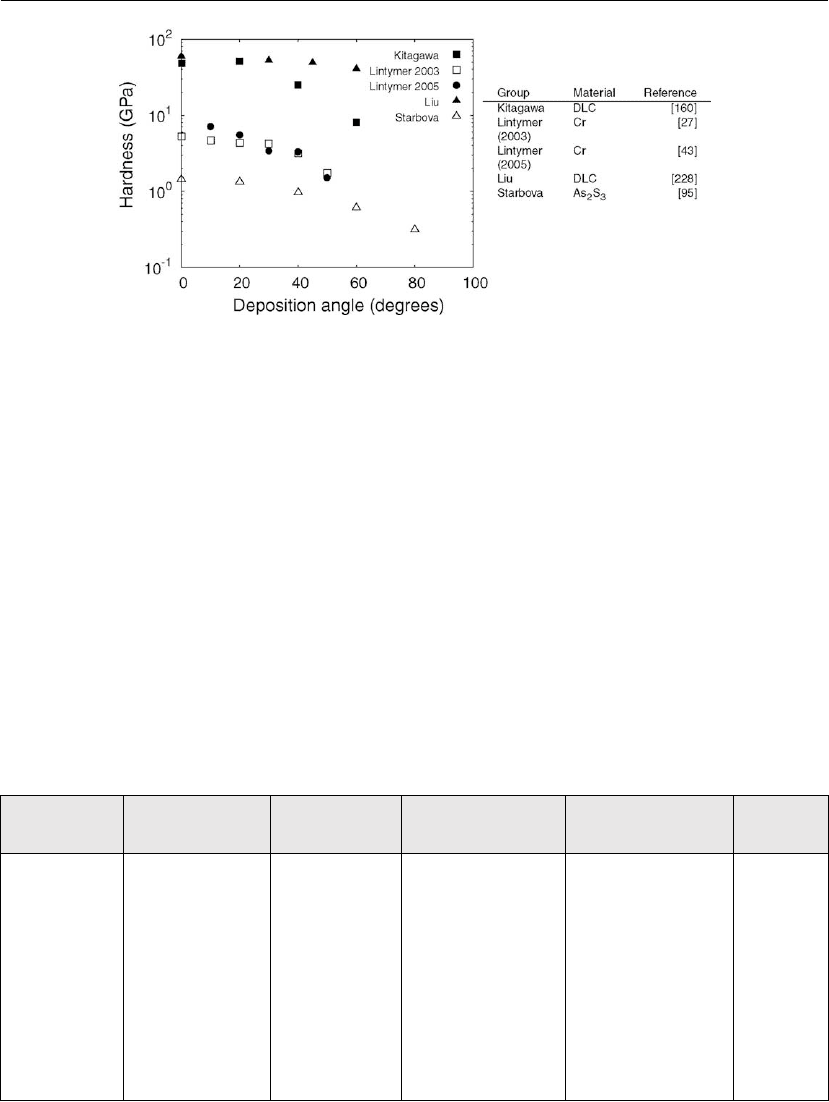
Glancing Angle Deposition 655
Figure 13.22: Literature values for GLAD thin film hardness. Hardness decreases with increasing
deposition angle. The Lintymer data are for Cr slanted posts (2003) and Cr chevrons (2005).
Although noisy, the Lintymer data suggest that the structure type and period number of a GLAD
film can affect hardness. Experimental data are described in the table. DLC: diamond-like carbon.
measurements, indentor size is large enough that an array of springs is probed in parallel,
although atomic force microscopy (AFM) measurements have been made of isolated columns
[229–231]. Limited measurements of shear resistance have been reported, but the result for
Ta
2
O
5
indicates, as expected, that GLAD films are more resistant to normally oriented stress
than shear stress. The Young’s modulus values exhibited by GLAD films depend on material
and deposition angle. Table 13.3 summarizes literature results.
Stress
Stress in GLAD films tends to be much reduced from that found in films deposited at α =0
◦
,
assuming equivalent thickness. Since a GLAD film is made up of isolated columns, it is free to
Table 13.3: Young’s and shear moduli of GLAD thin films
Material
Young’s Shear Structure Deflection Ref.
(GPa) (GPa) (nm)
Alq
3
0.93 – Helix 3.2 [233]
Cr 140 – Helix 60–70 [38]
80–170
a
– Slanted post – [27]
100–250
a
– Chevron – [43]
Ni 154 – Inverse helix 25 [186]
Si 94 ±10 – Slanted post – [231]
SiO 92 – Helix 60–70 [38]
Ta
2
O
5
0.375 0.06 Helix – [44]
Ti 110 – Helix 60–70 [38]
a
Non-monotonic dependence on α, measured for 0–50
◦
.

656 Chapter 13
undergo movement that is uncoupled over short length scales, which reduces stress. Stress in
GLAD films has been the subject of, or noted in, many reports [39, 159, 234–237]. Using
GLAD films as stress-reduction layers has been studied by Karabacak et al. [235] for W
slanted post films and Sumigawa et al. [236] for Ta
2
O
5
helical films. Initial work by Robbie
et al. reported a 0.01 GPa residual stress in MgF
2
thin films deposited at α =85
◦
[159, 234].
Similar results were reported by Jaing et al., who studied residual stress in MgF
2
films as a
function of deposition angle [237]. Jaing’s data indicate that stress depends non-linearly on α,
but remains below 0.3 GPa in magnitude for 0
◦
< α <70
◦
. Cuomo et al. report that stress
decreases in diamond-like carbon films as deposition angle increases [39].
Nanocarpet effect
The mechanical response of an ensemble of columns to a droplet introduced to the film has
been the subject of a few reports [238–240]. Such studies are important because they speak to
the robustness of GLAD devices outside a controlled laboratory environment. Fan et al.
studied the damage which occurs when a droplet strikes a vertical post GLAD film [238]. The
authors identify a central damage region due to droplet impact, a surrounding region of
columns which are tilted toward the center of the droplet as it spreads, and a final randomized
region as the droplet edge percolates through the film. This work has been followed up by
theoretical studies [239], and a study of droplet-induced damage as a function of GLAD
structure [240]. Slanted posts were found to be the most resistant to droplet-induced damage;
vertical posts the most susceptible.
13.4.2.5 Electrical Properties
Electrical properties of GLAD films have been studied by several groups [26, 27, 39,
241–243]. The development of columns can strongly affect the electrical properties of a
GLAD thin film, and a few trends are observed in literature reports. First, increasing α
increases in-plane resistivity as film density decreases, reducing the number of electrical
pathways available [27, 243]. For thin diamond-like carbon films, resistivity decreases as
incidence angle increases, probably due to an increasing number of sp
2
bonds [39]. Second,
the development of columnar microstructure breaks the electrical symmetry of a GLAD thin
film, exhibited as different electrical resistivities in directions parallel and perpendicular to the
GLAD nanocolumns. This anisotropy also increases with α [26, 241, 243], although a
maximum has been observed in Fe–Si multilayered structures [242]. GLAD film conductivity
is important in sensor and solar applications.
13.4.3 Bulk Properties
13.4.3.1 Optical Properties
The microstructural and nanostructural control provided by GLAD makes it ideally suited to
fabricating engineered optical materials, where optical properties are determined by the

Glancing Angle Deposition 657
structure. In thin films produced by PVD, the link between columnar structure and the film’s
optical properties is well known [244, 245]. The traditional focus of PVD optical coatings is to
produce homogeneous, robust, dense films. GLAD is a departure from this goal, aiming to
create unique properties in thin film materials. The optics of GLAD thin films has been studied
in great detail, so a very good understanding exists in the literature. Correspondingly, the
dominant application of GLAD thin films has been optical.
In the earliest works on oblique deposition, researchers observed polarization-sensitive
properties in obliquely deposited films [246]. Metallic films deposited at oblique incidence
were found to preferentially absorb one polarization state over the other, a property known as
dichroism. Similarly, transparent materials display birefringence [247]. The anisotropy
observed in obliquely deposited films is not generated by crystal structure or stress, rather it is
created by film structure.
In a stationary oblique deposition corresponding to a slanted post structure, the resulting film
will be optically biaxial [248]. To describe such a material, three refractive indices and their
respective orientations are required. These orientations are determined by the structure of the
slanted post and are (i) along the column axis, (ii) lying in the plane and parallel to the
broadening direction, and (iii) mutually orthogonal to the other two. A vertical post film is also
anisotropic. However, because the structure is symmetric in the substrate plane only two
refractive indices are required, one lying in and one perpendicular to the substrate plane [249].
The film is no longer biaxial, but instead the anisotropy is uniaxial.
Because of the structural control provided by the GLAD technique, optically isotropic
materials can be engineered into anisotropic forms. Furthermore, the anisotropic magnitude
and orientation can be varied throughout the thickness of the film via deposition angle
adjustment. These two properties of the GLAD technique are used to fabricate polarization
discriminating optics, discussed in Section 13.5.1.1.
Effective medium theories
GLAD thin films exhibit a distribution in column size, shape, and separation. Therefore,
predicting film optical properties from first principles is very difficult. However, in any
practical measurement, the beam spot is macroscopic in size and therefore averages over a
number of columns. This immediately suggests theoretically approaching GLAD films with
some sort of averaging method: exactly the basis of effective medium (EM) theory, which
attempts to replace a heterogeneous structured system with a homogeneous uniform
approximation that is much more amenable to further calculations [250, 251]. In general, the
refractive index of a two-component mixture will depend on many parameters. We therefore
define an effective refractive index n
e
,
n
e
= f
(
n
1
,n
2
,ρ
1
,λ,geometry
)
(13.12)

658 Chapter 13
where n
1
and n
2
are the indices of the two components, ρ
1
is the fraction of total volume
occupied by component 1 (ρ
1
+ ρ
2
= 1), and λ is the wavelength of light (which is most often
ignored based on a quasistatic approximation). n
e
is also influenced by system geometry,
which dictates the particular EM theory used. For example, the Maxwell–Garnett and
Bruggeman EM equations can be respectively derived from a separated-grain structure and an
aggregate structure [252]. The accuracy of a given EM theory depends on how well it
represents the underlying microstructure of the real sample, in addition to knowing precise
values for n
1
, n
2
, and ρ
2
. That said, EM approaches have been successfully used by many
researchers to approximate the properties of GLAD thin films [42, 253–256]. The anisotropy
seen in GLAD films can be quantitatively understood using generalized versions of the classic
Maxwell–Garnett and Bruggeman theories [257–260]. The Maxwell–Garnett equation is
n
2
e
− n
2
2
n
2
2
+ q
2
n
2
e
− n
2
2
+
n
2
2
− n
2
1
n
2
2
+ q
1
n
2
1
− n
2
2
ρ
1
= 0 (13.13)
and the Bruggeman equation is
n
2
1
− n
2
e
n
2
e
+ q
1
n
2
1
− n
2
e
ρ
1
+
n
2
2
− n
2
e
n
2
e
+ q
2
n
2
2
− n
2
e
ρ
2
= 0 (13.14)
In these theories, the constituent phases can adopt ellipsoidal shapes, providing a rough
approximation of columnar structure, through the depolarization tensors q
1
and q
2
. (In
application, the approximation q
1
= q
2
is often used.) For an ellipsoid with axes a, b, c, the
principal axes of the depolarization tensor are aligned with the ellipsoid and are given by
q
i
=
xyz
2
∞
0
ds
s + i
2
s + a
2
s + b
2
s + c
2
,i= a, b, c (13.15)
Tabulation of this integral for different ratios of the axes can be found in the literature [261].In
practice, however, the depolarization values q
a
, q
b
, and q
c
are used as fitting parameters in
numerical optimization, with the added constraint that q
a
+ q
b
+ q
c
=1.
Optical indices
The deposited film’s planar density is determined by shadow length and can, therefore, be
controlled with deposition angle. Varying the amount of bulk material in the film provides a
means of tuning the film’s refractive index. This has been demonstrated by many researchers
investigating various important optical materials. Optical constants have been reported for
many materials including dielectrics (TiO
2
[256, 262, 263],Ta
2
O
5
[247, 256],WO
3
[247],
Nb
2
O
5
[34], ZrO
2
[256, 264], HfO
2
[106], SiO
2
[42], MgF
2
[42], ZnS [68]), semiconductors
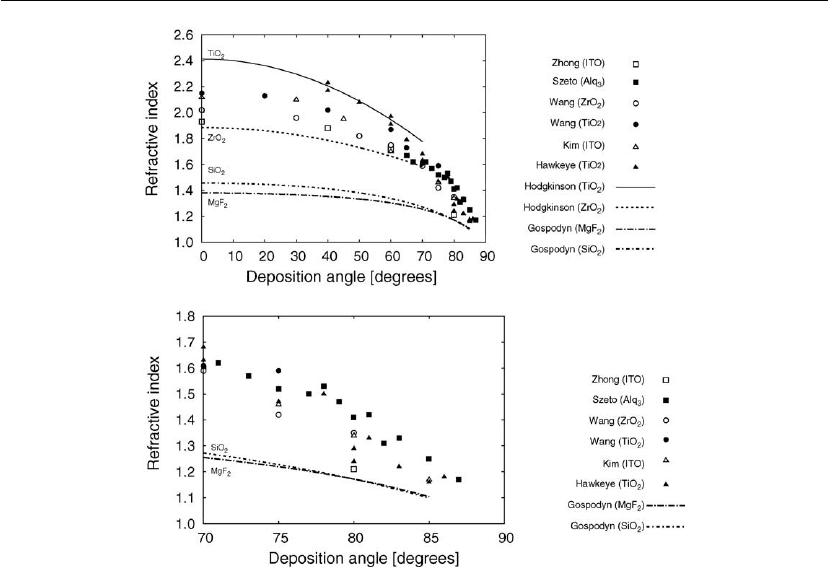
Glancing Angle Deposition 659
Figure 13.23: Optical index as a function of α for several optical materials. The top figure shows
the full range, while the bottom figure focuses on highly oblique angles. Literature references for
these and other materials may be found in the text.
(Si [249]), chalcogenides (a-As
2
S
3
[95, 265], a-As
2
Se
3
[265], a-GeSe
2
[266], GeSbSe [104]),
transparent conductors (ITO [267, 268]), and organics (Alq
3
[269]).
Figure 13.23 shows several data sets taken from the literature. The general relationship
between n and α is continuous and monotonic; increasing α lowers the film’s planar density
and reduces n.Atlowα, the deposited film is dense, with only a small fraction of void region,
and n approaches bulk thin film values. At high α, the film is highly porous and n
asymptotically approaches unity. This can be seen in Figure 13.23, where as α nears 90
◦
, the
data sets converge toward n = 1, regardless of material.
Of particular note in Figure 13.23 are the data sets of the same material from different
publications. Wang et al., Hawkeye and Brett, and Hodgkinson et al. all studied TiO
2
structures. Wang et al. [262] and Hodgkinson et al. [256] studied slanted post structures and
Hawkeye and Brett [263] examined vertical post structures. Additionally, these investigations
used different measurement techniques, with Wang et al. using Swaneopel’s method, Hawkeye
and Brett fitting reflectance data, and Hodgkinson et al. using an ellipsometric technique. What
can be seen in the data sets is good but not perfect agreement, which is quite reasonable given

660 Chapter 13
the sensitivity of TiO
2
films to preparation conditions [270]. A similar conclusion can be
reached in the reported optical constants of ITO from Zhong et al. [268] and Kim et al. [267],
and of ZrO
2
from Wang et al. [264] and Hodgkinson et al. [256]. The agreement between these
data sets highlights the applicability and reproducibility of the GLAD technique in controlling
refractive index. While sensitivity to preparation conditions is an issue, it is a concern in any
thin film manufacturing and process variables must always be optimized.
13.4.4 GLAD Properties Summary
One of the challenges for GLAD is rooted in the very aspect that makes GLAD films of such
interest: the combination of different length scales together with the corresponding physics,
into a single material. As we have seen in this section, understanding the behavior of GLAD
columns requires well-developed nanoscale physics. In many cases, this understanding has not
yet developed. While ballistic and Monte Carlo simulation methods are well developed, they
are limited by our knowledge of the physics. Molecular dynamics simulations are one way to
discover new phenomena from the bottom up, and current practical simulation sizes are nearly
at a useful scale for GLAD films. While increasing computer speed and improved molecular
dynamics simulation techniques will ease this burden, an increased theoretical effort will be
required.
As the length scale increases, the physical understanding improves. The mid-range effects,
such as surface area and mechanical properties, are more easily addressed experimentally, and
have a better developed set of models on which to draw. The large-scale effects, such as optical
properties, are well understood, and here the design of GLAD films for particular applications
becomes much more straightforward. As we will see in the next section, the dominant
applications of GLAD reflect this superior understanding of the long length scale effects.
However, as a better understanding of the nanoscale physics present in GLAD develops,
exciting new applications of GLAD films are anticipated.
13.5 GLAD Applications
GLAD thin films have found application in many fields, exploiting the properties discussed in
the previous section. The dominant application of GLAD thin films is optical, reflecting in part
the well-developed theoretical support, combined with the ease with which GLAD can control
structure on a scale relevant to optical applications. Many applications, including sensor,
catalysis, and energy applications, rely on the extremely large surface areas of GLAD thin
films. In this section, we review a selection of the diverse applications to which GLAD films
have been applied. The focus is on optical and sensor applications, with brief discussions of
mechanical devices, catalysis applications, magnetic data storage, energy applications, and
manufacturability of GLAD thin films.
